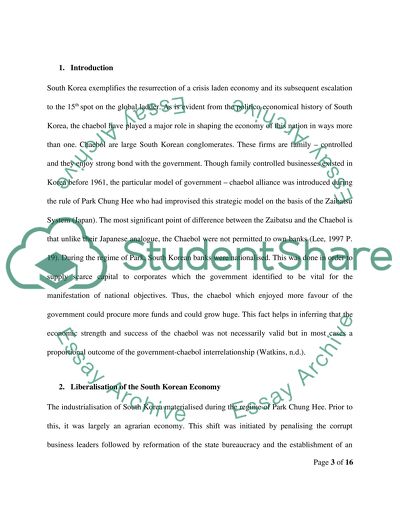Cite this document
(“At the heart of South Koreas developmental strategy over the past four Essay”, n.d.)
At the heart of South Koreas developmental strategy over the past four Essay. Retrieved from https://studentshare.org/miscellaneous/1561850-at-the-heart-of-south-koreas-developmental-strategy-over-the-past-four-decades-are-the-close-ties-between-government-and-the-family-controlled-chaebols-discuss-the-nature-of-these-ties-and-explain-how-they-have-caused-problems-for-the-korean-economy-in
At the heart of South Koreas developmental strategy over the past four Essay. Retrieved from https://studentshare.org/miscellaneous/1561850-at-the-heart-of-south-koreas-developmental-strategy-over-the-past-four-decades-are-the-close-ties-between-government-and-the-family-controlled-chaebols-discuss-the-nature-of-these-ties-and-explain-how-they-have-caused-problems-for-the-korean-economy-in
(At the Heart of South Koreas Developmental Strategy over the past Four Essay)
At the Heart of South Koreas Developmental Strategy over the past Four Essay. https://studentshare.org/miscellaneous/1561850-at-the-heart-of-south-koreas-developmental-strategy-over-the-past-four-decades-are-the-close-ties-between-government-and-the-family-controlled-chaebols-discuss-the-nature-of-these-ties-and-explain-how-they-have-caused-problems-for-the-korean-economy-in.
At the Heart of South Koreas Developmental Strategy over the past Four Essay. https://studentshare.org/miscellaneous/1561850-at-the-heart-of-south-koreas-developmental-strategy-over-the-past-four-decades-are-the-close-ties-between-government-and-the-family-controlled-chaebols-discuss-the-nature-of-these-ties-and-explain-how-they-have-caused-problems-for-the-korean-economy-in.
“At the Heart of South Koreas Developmental Strategy over the past Four Essay”, n.d. https://studentshare.org/miscellaneous/1561850-at-the-heart-of-south-koreas-developmental-strategy-over-the-past-four-decades-are-the-close-ties-between-government-and-the-family-controlled-chaebols-discuss-the-nature-of-these-ties-and-explain-how-they-have-caused-problems-for-the-korean-economy-in.


